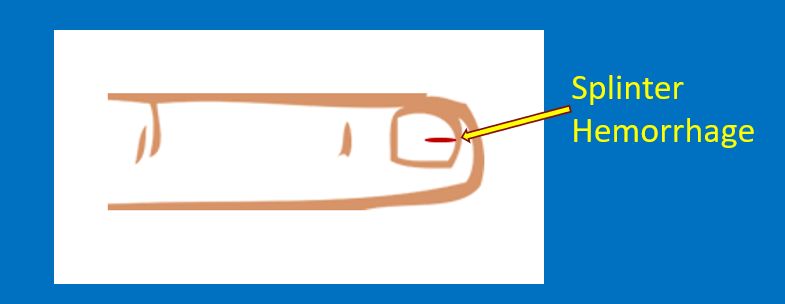General examination – hands and feet
General examination – hands and feet
Cyanosis and pallor can be noted in the tips of the digits. Severe jaundice may be visible in the palms and soles, especially in small infants.
- Clubbing of digits may be noted in cyanotic heart diseases as well many other non cardiac conditions. In clubbing, initially there is fluctuation of nail bed (Grade 1) followed by obliteration of angle between nail and adjacent skin fold (Lovibond angle – Grade 2). Later there is curvature of the nails (parrot beaking – Grade 3). Grade 4 or hypertrophic osteoarthropathy is not common in cardiovascular causes of clubbing, hence the term hypertrophic pulmonary osteoarthropathy. It is a triad of periostitis, digital clubbing and painful arthropathy of the large joints, classical of lung cancer.

- Osler’s nodes are tender reddish spots on the distal aspects of the fingers and toes, noted in infective endocarditis.
- Janeway lesions are non tender erythematous patches on the palms and soles, seen in in infective endocarditis.
- Heberden’s nodes are bony outgrowths from the margin of the distal interphalangeal joints, a feature of osteoarthritis.
- Splinter hemorrhages are linear streaks in the nail bed, typically seen in infective endocarditis, though it can also occur with trauma.

- Dupuytren’s contracture which affects the ring and little finger may be associated with cirrhosis of the liver, though it can occur without cirrhosis as well.
- Arachnodactyly or long slender digits resembling those of arachnids (spider family) is a feature of Marfan syndrome.
- Polydactyly with extra digits is part of Ellis-Van Creveld syndrome which has in addition short stature and cyanotic congenital heart disease (single atrium).
- Edema is collection of fluid in the subcutaneous tissue. If it is unilateral, the cause is local like lymphedema or deep vein thrombosis (clotting of blood in deep veins of the legs). Pitting edema is demonstrated by sustained pressure over the lower part of tibia to displace the fluid and form a pit. Long standing edema may be non pitting. Bilateral pedal edema can occur in cardiac, renal or hepatic failure as well as hypoproteinemia and hypothyroidism.